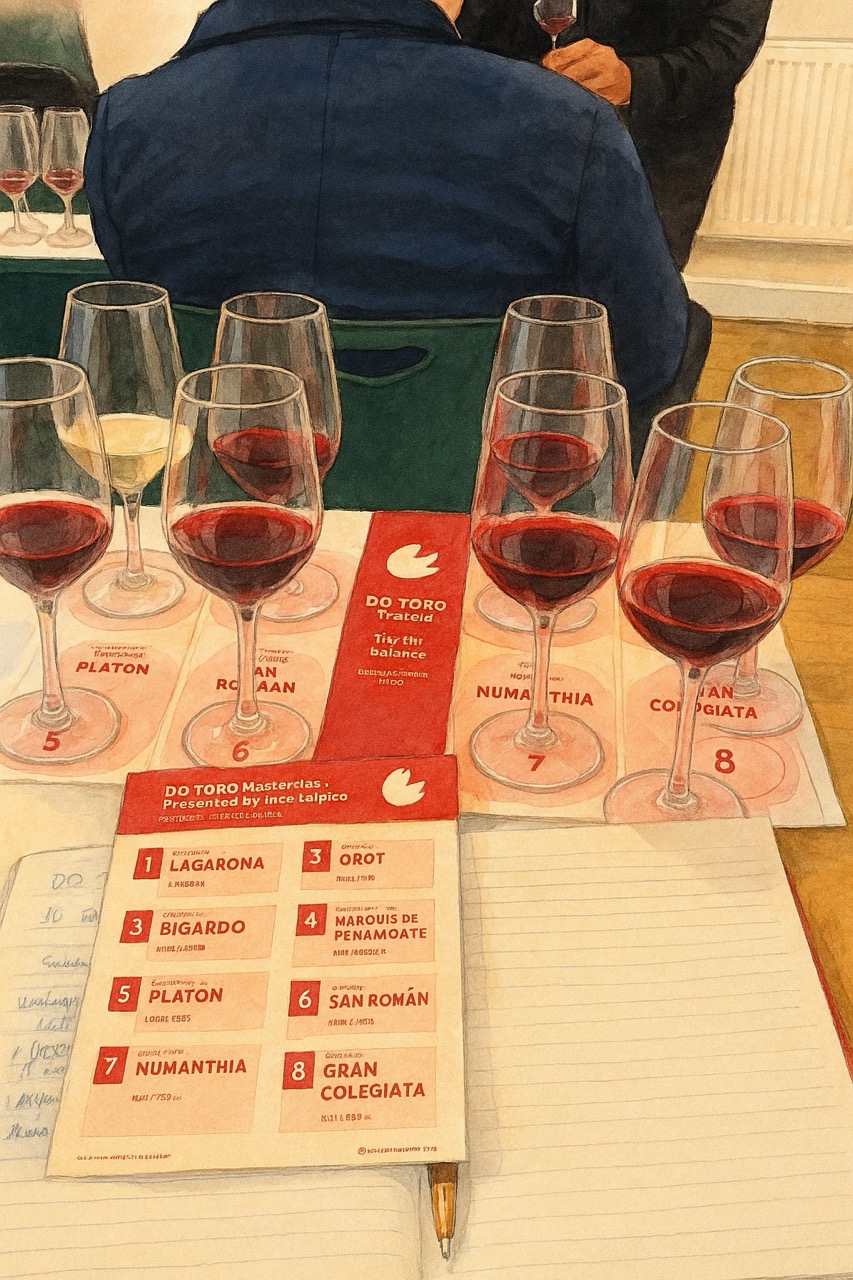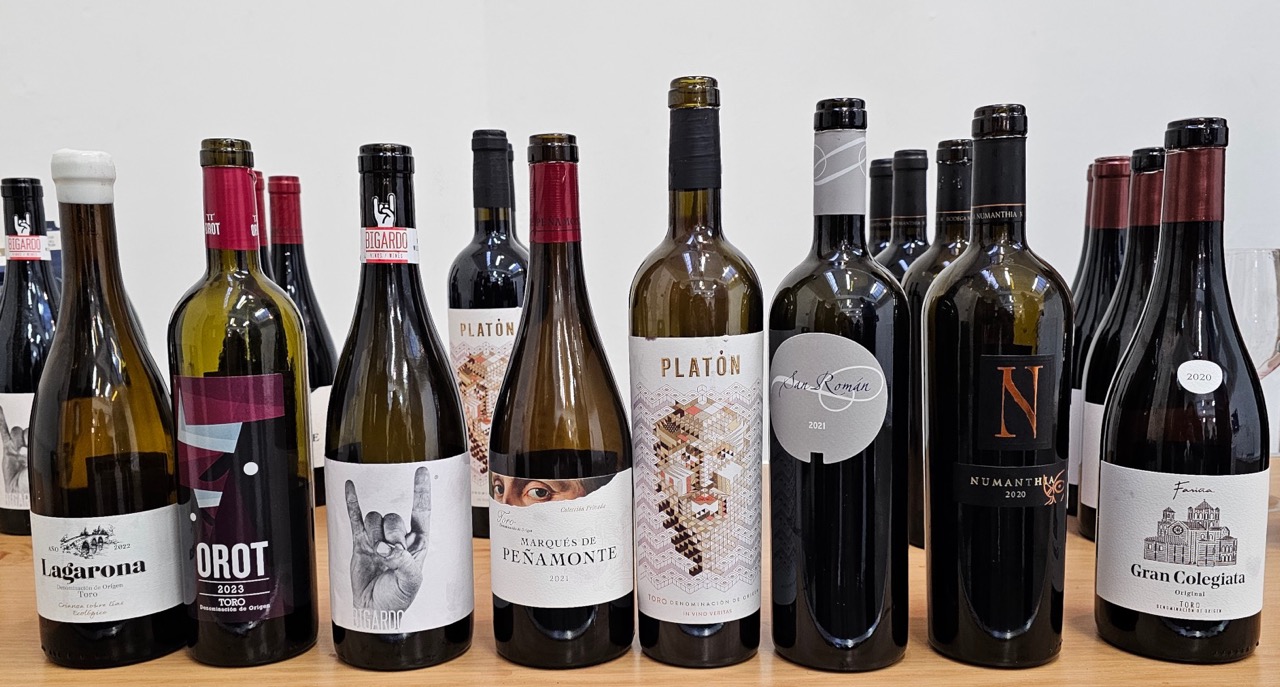24 Oct 2025
Touring Toro
There is more to Spanish wine than Rioja

Another week. Another region to explore.
I am a big fan of Spanish wine and some of my favourites have been made in Rioja, Priorat and Ribera del Duero. While I’ve heard of Toro, I must admit it has flown under my radar, and it is only a stones throw from Ribera del Duero.
So how does it compare?
To find out, I headed to Conway Hall for a masterclass hosted by Ines Salpico.
A climate of extremes
It would be fair to describe the climate of Toro as extreme. It gets very cold over winter (which can be troublesome for the vine) while the summer is very hot and dry, combine this with low annual rainfall (350-400mm per year) and you get a rather inhospitable environment for vegetation...
However, there are some positives:
- 2,600-3,000 annual sunshine hours aids grape ripening.
- Cool nighttime conditions due to the altitude helps retain acidity.
- Its warm and dry which helps to lower disease pressure.
Actually, these are perfect conditions for exceptional grape growing.
The vine rooted in regional identity
Wine is deeply rooted in the regional identity. The Romans introduced viticulture to the Duero basin in 210BC. Specifically in Toro, there are documents from the 16th Century that recognised its viticulture and its economic impact, and further an Oenological station was established there in 1882.
Toro also escaped the worst of phylloxera when it hit Spain in the 1870s. The loose and well-drained sandy soils resist the parasite and the key indigenous grape, Tinta de Toro, a Tempranillo varietal that is phylloxera resistant.
Today, most of the vines are ungrafted pre-phylloxeran stock. As such, Toro boasts the highest proportion of old vines in Europe! This means smaller yields but more concentrated grapes.
The Bodegas
Wine production is a real community effort supported by 905 growers. These growers, faithful to their small plots and armed with deep knowledge of their terroir work with 64 Bodegas that are responsible for the wine making. 85% of the vineyards are bush vines and harvested by hand. It's very much a rustic vibe.
Most of the producers are now practicing sustainable and organic farming, but the approach each Bodega follows is slightly different and there is a wide range of viticulture and winemaking in action.
Bigardo describes themselves at natural, minimising intervention to preserve fruit character. Torreduero and Numanthia similarly anchor sustainable and organic farming at the heart of their production.
San Roman, are in the process of becoming Biodynamic certified. I am still not convinced on the benefit of aligning sustainable and organic practices to astrological calendars. I spoke to the producer to find out why? They responded “can you explain love?”. Well maybe not. That’s the thing with great winemaking. In some ways it is irrational. It is an artform. There is a romance that compels top winemakers to dive deep into their practices, in such a mindful way and the end result is greatness.
I will give biodynamic viticulture some credit. The overarching belief is to treat the earth (vineyard) as “a living and receptive organism”. So while it lacking in science, at its heart, the approach is deeply mindful and overall the practices are in the best interests of the health of the vineyard ecosystem.
At the other end, at Farina, sensors collect data to determine the health of the vineyard. Using this data, nutirent requirements can be met with precision, the vine can be irrigated down to the drop and fungal disease predicted so any chemical treatments timed most effectively (and as a consequence reduced). This is a mindful scientific approach that also aims to improve quality.
The wines

95% of the wines in DO Toro are red and most of that is Tinta de Toro. Seven of the line-up are made with this indigenous variety. White wines are rare. In the past they were cofermented with black grapes (Cote Rotie style) to help balance and soften, but with advances in winemaking this balance can be achieved without adding white grapes. This means there is small production of whites, and we start off with one.
So how do they taste?
The lonely white
Bodegas Piedra, Lagarona
Pale lemon. Medium+ intensity. Wet stones with some salinity. Citrus fruits, particularly grapefruit and lemon. Notes of butter. Medium acidity which leaves it a bit flat but there is some texture and the finish is long.
The fruity pair
Bodega Bucrana, Orot
Deep ruby. Medium+ intensity. Red plum, black plum. Spice and black pepper. On the palate the fruits are fresh anc ripe leaning into red with a medium+ finish. Medium+ tannins that are ripe and persistent.
Bodegas Bigardo, Bigardo
Deep garnet. Medium+ intensity. Richer and darker fruits; black plum, blackcurrant with violet floral notes. Spice and black pepper. On the palate, the tannins are high and black plum dominates. Medium+ finish. Acidity medium.
The big ones
Bodegas Torreduero, Marqués de Peñamonte
Very rich. Pronounced intensity. The fruit is very concentrated like ribena. Blackberry, blackcurrant, violets and liquorice. Clear oak influence. Felt quite closed and tight. Medium+ tannins that are ripe but well integrated. Blackcurrant comes through on the palate with a medium finish.
Bodega y Viñedos Divina Proporción, Platón
Deep ruby. Medium+ intensity. 100-year-old vines, yet the red fruit notes are delicate. Oak aromas with some violet and liquorice. Tannins high. Acidity medium. Would benefit from some aeration - when I came back, it was opening up with dried fruits; prunes and raisins.
Bodega Numanthia, Numanthia
Deep ruby. Medium+ intensity. Delicate aromas; black fruits - blackberry, blackcurrant and blueberry. Oak and cedar. Violets. Tannins are high - very ripe, not hard but very persistent. Medium acidity. Plums on the palate, long finish.
San Román Bodegas y Viñedos, San Román
Described as the "winemaker's wine". Deep purple-ruby. Pronounced. Cedar, cloves, smoke. Spices, black pepper. Violets, black fruits. Medium+ acidity helps achieve balance. Medium+ tannins very well integrated. Long finish - black fruits. Amazing wine.
Bodegas Fariña, Gran Colegiata
This was the only reserva in the line-up. Oak hits me first: cedar, cloves, smoke. Spice, black pepper. Blackberry and blackcurrant. Tobacco and leather giving hints on tertiary development. Medium acidity. High tannins — ripe and chewy.
Toro - worth a tour?
The acidity of these wines was noticeably lower than other regions I’ve explored. This wasn’t a problem with the reds as other structural components helped maintain balance. However, I felt this negatively impacted the white wine and this lack of acidity made it feel a bit flat and lifeless.
I would consider these gastronomic wines that would definitely be lifted when accompanied by food. There was so much concentration and power that needs to be tempered. With a bit more time in the bottle or some food the wines will calm down so they can be enjoyed fully.
Not all of the wines are like this, and most of the reds made in Toro are made in a much more fruity style. If you're a Beaujolais fan, then you'll know what to expect.
In the face of extremes, Toro has been able to deliver high quality wines that I would recommend alongside other Spanish regions.
So next time you're exploring a wine menu, or checking out bottles in a shop, maybe take a tour of Toro!